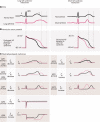Genetics of cardiac arrhythmias
- PMID: 16162633
- PMCID: PMC1769155
- DOI: 10.1136/hrt.2004.046334
Genetics of cardiac arrhythmias
Figures


References
-
- Roden DM, Balser JR, George AL Jr, et al. Cardiac ion channels. Annu Rev Physiol 2002;64:431–75. - PubMed
-
- Clancy CE, Kass RS. Inherited and acquired vulnerability to ventricular arrhythmias: cardiac Na+ and K+ channels. Physiol Rev 2005;85:33–47. - PubMed
-
- Mohler PJ, Schott JJ, Gramolini AO, et al. Ankyrin-B mutation causes type 4 long-QT cardiac arrhythmia and sudden cardiac death. Nature 2003;421:634–9. - PubMed
-
- Plaster NM, Tawil R, Tristani-Firouzi M, et al. Mutations in Kir2.1 cause the developmental and episodic electrical phenotypes of Andersen’s syndrome. Cell 2001;105:511–9. - PubMed
-
- Splawski I, Timothy KW, Sharpe LM, et al. Ca(V)1.2 calcium channel dysfunction causes a multisystem disorder including arrhythmia and autism. Cell 2004;119:19–31. - PubMed
Publication types
MeSH terms
Substances
LinkOut - more resources
Full Text Sources
Other Literature Sources
Medical
